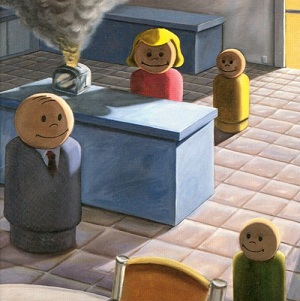
For many people, the term "emo" implies the nerdy kid at your high school who wore girls' jeans and dyed his hair black. Knowing what real emo music is, however, this association has always gotten on my nerves. Hence, I decided to write on what emo really is- mythbusting, blog style.
Emo music began as an offshoot of hardcore punk, when many bands began writing less hard songs and turning to more "EMOtional" sounds, thus the name was born. Known DC hardcore heads such as Ian Mackeye and Guy Piccioto were key players in the development of emo, as they turned from the bands of their younger days (Minor Threat, etc.), and began to wrote perhaps more mature music, in bands such as Fugazi and Rites of Spring. 1985 saw the birth of both bands, each developing a more progressive and experimental sound than the straightforward hardcore of the early 1980's. Ian Mackeye's record label, Dischord Records, provided a springboard for many of these bands. The turn of the decade saw many simliar-minded bands developing, which progressed from the traditional simplistic elements of hardcore into more melodic and experimental approaches. New York bands such as Texas is the Reason and Quicksand, featuring Walter of Gorilla Biscuits and Youth of Today fame, took the sound of experimental hardcore bands and turned it more toward the sound which Mackeye had been experimenting with in Fuagzi. The momentum of bands like Fugazi influenced many other early 90's emo bands such as Sunny Day Real Estate to release records, which further developed the traditional emo sound. The following years saw many major emo acts rise to popularity. Groups such as Braid, Cap'n Jazz, the Promise Ring, and Mineral all released albums considered to be pillars of "traditional" emo in the years between 1990-2000.

Similar-minded emo forefathers, Jimmy Eat World and Weezer, both released landmark albums in 1996, Static Prevails and Pinkerton. These two bands can be credited to bringing the emo sound to mainstream audiences. The broad success of these records brough major label attention to emo, and eventually brought emo music to mainsream pop music. Bands such as Dashboard Confessional, Saves the Day, Taking Back Sunday, Hot Water Music, Brand New, and New Found Glory brought pop sensibilities and more accessible sounds to emo music, and saw major success in the early 2000's, fully achieving the crossover of emo into pop music.
It is at this time that the history of emo diverges. Emo has become mainstream, much due to the exposure of pop culture staples MTV, and the annual Vans Warped Tour. Popular emo music began straying further and further from the roots of the genre- so much so that I would say the acts labelled as "emo" in the 21st century (The Used, Fallout Boy, My Chemial Romance, Panic!, etc etc.) have been anything but emo. Many of these bands used over-the-top dramatic and theatric elements which are NOT traditionally a part of emo in anyway. Sadly, these elements have come to be associated with the emo genre, and dare I say, soiled the good name of emo forever. Hence, for most mainstream music fans, "emo" has become a catch-all phrase to describe most alternative or punk music- everything from Death Cab for Cutie to The Smiths (yes I have heard both described as emo). So next time you are about to call your local eyeliner wearing hipster "emo" take a second and remember what emo REALLY is.
Suggested listening: Fugazi, Rites of Spring, Jawbreaker, Sunny Day Real Estate, Seaweed, Knapsack, Samiam, the Promise Ring, American Football, Mineral.

No comments:
Post a Comment